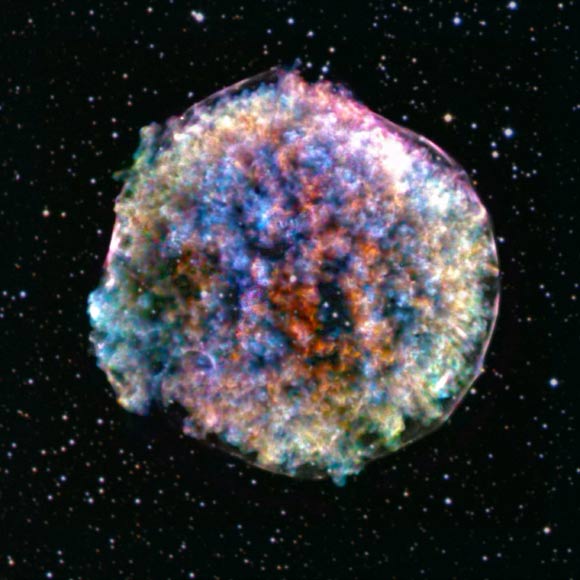Chandra Sheds New Light on Tycho’s Supernova Remnant | Astronomy – Sci-News.com
X-ray images of Tycho’s supernova remnant (Tycho’s SNR) show a pattern of bright clumps and fainter holes. By comparing new data from NASA’s Chandra X-ray Observatory to computer simulations, astronomers have found evidence that the supernova explosion itself, not something in its aftermath, was the source of this clumpy distribution.

This image of Tycho’s SNR from NASA’s Chandra X-ray Observatory reveals an intriguing pattern of bright clumps and fainter holes. To emphasize these features, two narrow ranges of X-ray energies were selected to isolate material (silicon, colored red) moving away from Earth, and moving towards us (also silicon, colored blue). The other colors in the image (yellow, green, blue-green, orange and purple) show a broad range of different energies and elements, and a mixture of directions of motion. Chandra’s X-ray data are shown alongside an optical image of the stars in the same field of view from the Digitized Sky Survey. Image credit: NASA / CXC / RIKEN / NASA’s Goddard Space Flight Center / T. Sato et al / DSS.
Tycho’s supernova, also known as SN 1572 or Tycho’s Nova, was discovered by the Danish astronomer Tycho Brahe in November 1572.
Modern astronomers know that the event was a Type Ia supernova, caused by the explosion of a white dwarf.
The stellar explosion spewed elements like silicon and iron into space at speeds of more than 5,000 km/s.
As with many supernova remnants, Tycho’s SNR glows brightly in X-ray light because shock waves generated by the explosion heat the debris up to millions of degrees.
The X-ray images show an intriguing pattern of bright clumps and fainter areas in the object.
“What caused this thicket of knots in the aftermath of this explosion?” asked Dr. Toshiki Sato, an astronomer at RIKEN, NASA’s Goddard Space Flight Center, and the University of Maryland, and colleagues.
“Did the explosion itself cause this clumpiness, or was it something that happened afterward?”
To emphasize the clumps in the Chandra image and the 3D nature of Tycho’s SNR, Dr. Sato’s team selected two narrow ranges of X-ray energies to isolate material (silicon, colored red) moving away from Earth, and moving towards us (also silicon, colored blue).
The other colors in the image (yellow, green, blue-green, orange and purple) show a broad range of different energies and elements, and a mixture of directions of motion.
By comparing the Chandra image to two different computer simulations, the astronomers were able to test their ideas against actual data.
One of the simulations began with clumpy debris from the explosion. The other started with smooth debris from the explosion and then the clumpiness appeared afterwards as the supernova remnant evolved and tiny irregularities were magnified.
A statistical analysis using a technique that is sensitive to the number and size of clumps and holes in images was then used.
Comparing results for the Chandra and simulated images, Dr. Sato and co-authors found that Tycho’s SNR strongly resembles a scenario in which the clumps came from the explosion itself.
While the scientists are not sure how, one possibility is that star’s explosion had multiple ignition points, like dynamite sticks being set off simultaneously in different locations.
Their results were published in the Astrophysical Journal.
Another team of astronomers, led by RIKEN astronomer Dr. Gilles Ferrand, constructed their own 3D computer models of a Type Ia supernova remnant as it changes with time.
The team’s work, also published in the Astrophysical Journal, shows that initial asymmetries in the simulated supernova explosion are required so that the model of the ensuing supernova remnant closely resembles the Chandra image of Tycho, at a similar age.
_____
Toshiki Sato et al. 2019. Genus Statistic Applied to the X-Ray Remnant of SN 1572: Clues to the Clumpy Ejecta Structure of Type Ia Supernovae. ApJ 879, 64; doi: 10.3847/1538-4357/ab24db
Gilles Ferrand et al. 2019. From Supernova to Supernova Remnant: The Three-dimensional Imprint of a Thermonuclear Explosion. ApJ 877, 136; doi: 10.3847/1538-4357/ab1a3d






